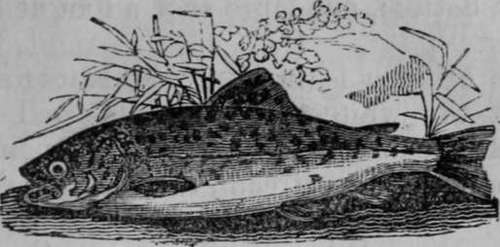A Description Of A Trout
Description
This section is from the book "The Art Of Angling Greatly Improved", by An Unknown Author. Also available from Amazon: The Art of Angling Greatly Improved.
A Description Of A Trout
There are few fish that afford the angler greater diversion than the Trout; they are at all times exceedingly circumspect, and for which reason it is in vain to angle when the water is low, as they then retire under the banks and roots, refusing every kind of bait. On a cloudy day after a gentle shower, they will freely take Minnows, worms, and flies of all kinds in their proper season. In March or April, angle for them with the worm in the afternoon, and with a fly or Minnow, according to the state of the water, the remainder of the day. The natural flies best adapted are the may-fly or yellow cadow, the grey drake, the orl, and the canon or downhill flv, all of which are to be found in bush-es near to the river-side in the months of May and June. Angle in the swiftest and sharpest currents, provided the day be clear and bright, and in the deeps early and late; but if the water be discoloured, or very thick, angle in the gravelly shallows near the sides and tails of streams with a worm only, to run on the bottom, one large shot a foot at least from it.

The Minnow is the best of all baits for the Trout, the whitest and middle-sized ones should be chosen. Angle with the point of the rod down the stream, drawing the Minnow up the stream by degrees near the top of the water. When the Trout sees the bait, he will dart most fiercely at it, but be careful not to snatch it away; and never strike until he has turned with the bait.
Trout fishing requires a strong rod, although not quite so stiff as what is used for Pike fishing ; the longer it is the better, provided it be not heavy. The line should be about a foot longer than the rod, and about eighteen inches of strong gut, or Indian weed, should be put to the end of it, twisted threefold, with a swivel to fix the bottom link upon, with four or five duck shot split and fastened on it. The hook should be 5 or 6.
In ground angling the bait should be a large lob-worm, or two marsh or dew worms, well scoured and very lively. The bait being cast in, let it gently drag on the bottom; when the fish begins to bite, do not strike the first time you feel the tug, but rather slacken the line; when you feel two or three sharp tugs then strike smartly, and if a heavy fish give him line, and be not in too great haste to land him.
To prepare the tackle for Trout fishing m a stream, a small piece of music-wire should be whipped to the upper end of the shank of the hook, for the purpose of keeping the bait in a proper position. No precise directions can be given for leading the line, as it depends so much on its length, the depth of the stream, and the rapidity of the current; the bait should sink quickly, and fish near the bottom. If the line be over-leaded it will be f*und extremely troublesome, as the hook will frequently be entangled with whatever it meets at the bottom, such as stones, roots ci trees, rushes, etc.
The following method of taking Trout lg highly recommended by some experienced anglers: Make a pair of wings of the feathei of a land-rail, and on the bend of the hook put one or two cadis, the heads of the cadlv being kept close to the wings. Angle with rod about five yards long, the line three, and the hook No. 3 or 4. Let the bait floa„ down the stream just below the surface, then gently draw it up again a little irregularly, by shaking the rod, and if there be a fish in the place it will be sure to take it. If two cadis be used with the wings, put the hook in at the head or out of the neck of the first, and quite through the other from head to tail. Two brandlings, or small red worms, may be fished with in the same way.
Continue to:
